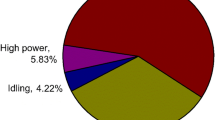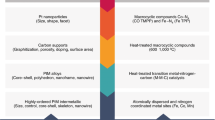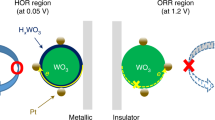Abstract
Fuel cell heavy-duty vehicles (HDVs) require increased durability of oxygen-reduction-reaction electrocatalysts, making knowledge of realistic degradation mechanisms critical. Here identical-location micro-X-ray fluorescence spectroscopy was performed on membrane electrode assemblies. The results exposed heavy in-plane movement of electrocatalyst after HDV lifetime, suggesting that electrochemical Ostwald ripening may not be a local effect. Development of local loading hotspots and preferential movement of electrocatalyst away from cathode catalyst layer cracks was observed. The heterogeneous degradation exhibited by a modified cathode gas diffusion layer membrane electrode assembly after HDV lifetime was successfully quantified by the identical-location approach. Further synchrotron micro-X-ray diffraction and micro-X-ray fluorescence experiments were performed to obtain the currently unknown correlation between electrocatalyst nanoparticle size increase and loading change. A direct correlation was discovered which developed only after HDV lifetime. The work provides a route to engineer immediate system-level mitigation strategies and to develop structured cathode catalyst layers with durable electrocatalysts.

This is a preview of subscription content, access via your institution
Access options
Access Nature and 54 other Nature Portfolio journals
Get Nature+, our best-value online-access subscription
$29.99 / 30 days
cancel any time
Subscribe to this journal
Receive 12 digital issues and online access to articles
$119.00 per year
only $9.92 per issue
Buy this article
- Purchase on Springer Link
- Instant access to full article PDF
Prices may be subject to local taxes which are calculated during checkout






Similar content being viewed by others
Data availability
The authors declare that the data supporting the findings of this study are available within the article and its Supplementary Information. Source data are provided with this paper.
References
Cook, D. Engines for change. Union of Concerned Scientists https://www.ucsusa.org/resources/engines-change (2015).
Inventory of US Greenhouse Gas Emissions and Sinks, 1990 to 2020. 430-R-22-003 (EPA, 2020).
Papageorgopoulos, D. Fuel cell R&D overview. In 2019 Annual Merit Review and Peer Evaluation Meeting (US Department of Energy, 2019).
Cherevko, S., Kulyk, N. & Mayrhofer, K. J. J. Durability of platinum-based fuel cell electrocatalysts: dissolution of bulk and nanoscale platinum. Nano Energy 29, 275–298 (2016).
Meier, J. C. et al. Design criteria for stable Pt/C fuel cell catalysts. Beilstein J. Nanotechnol. 5, 44–67 (2014).
Borup, R. L. et al. Recent developments in catalyst-related PEM fuel cell durability. Curr. Opin. Electrochem. https://doi.org/10.1016/j.coelec.2020.02.007 (2020).
Borup, R. et al. Scientific aspects of polymer electrolyte fuel cell durability and degradation. Chem. Rev. 107, 3904–3951 (2007).
Yu, H. et al. Tracking nanoparticle degradation across fuel cell electrodes by automated analytical electron microscopy. ACS Nano https://doi.org/10.1021/acsnano.2c02307 (2022).
Lee, C. et al. Toward a comprehensive understanding of cation effects in proton exchange membrane fuel cells. ACS Appl. Mater. Interfaces https://doi.org/10.1021/acsami.2c07085 (2022).
Annual Energy Outlook 2019 with Projections to 2050 (US Energy Information Administration, 2019); https://www.eia.gov/outlooks/ieo/pdf/ieo2019.pdf
Perez-Alonso, F. J. et al. Identical locations transmission electron microscopy study of Pt/C electrocatalyst degradation during oxygen reduction reaction. J. Power Sources 196, 6085–6091 (2011).
Gilbert, J. A. et al. Pt catalyst degradation in aqueous and fuel cell environments studied via in-operando anomalous small-angle X-ray scattering. Electrochim. Acta 173, 223–234 (2015).
Stariha, S. et al. Recent advances in catalyst accelerated stress tests for polymer electrolyte membrane fuel cells. J. Electrochem. Soc. 165, F492–F501 (2018).
Lazaridis, T., Stühmeier, B. M., Gasteiger, H. A. & El-Sayed, H. A. Capabilities and limitations of rotating disk electrodes versus membrane electrode assemblies in the investigation of electrocatalysts. Nat. Catal. 5, 363–373 (2022).
Khedekar, K. et al. Probing heterogeneous degradation of catalyst in PEM fuel cells under realistic automotive conditions with multi-modal techniques. Adv. Energy Mater. 11, 2101794 (2021).
Khedekar, K. et al. Effect of commercial gas diffusion layers on catalyst durability of polymer electrolyte fuel cells in varied cathode gas environment. Small 18, e2201750 (2022).
Yu, H. et al. Recreating fuel cell catalyst degradation in aqueous environments for identical-location scanning transmission electron microscopy studies. ACS Appl. Mater. Interfaces https://doi.org/10.1021/acsami.1c23281 (2021).
Cheng, L. et al. Mapping of heterogeneous catalyst degradation in polymer electrolyte fuel cells. Adv. Energy Mater. 10, 2000623 (2020).
Martens, I. et al. Imaging heterogeneous electrocatalyst stability and decoupling degradation mechanisms in operating hydrogen fuel cells. ACS Energy Lett. 6, 2742–2749 (2021).
Greenhouse Gas Emissions and Fuel Efficiency Standards for Medium- and Heavy-Duty Engines and Vehicles—Phase 2 (US Environmental Protection Agency, 2016); https://www.govinfo.gov/content/pkg/FR-2016-10-25/pdf/2016-21203.pdf
Geyer, H. K. & Ahluwalia, R. K. GCtool for Fuel Cell Systems Design and Analysis: User Documentation (US Department of Energy, 1999); https://www.osti.gov/servlets/purl/12005-vi2ISw/webviewable/
Cullen, D. A. et al. New roads and challenges for fuel cells in heavy-duty transportation. Nat. Energy 6, 462–474 (2021).
Inaba, M. et al. The oxygen reduction reaction on Pt: why particle size and interparticle distance matter. ACS Catal. 11, 7584–7594 (2021).
Schröder, J. et al. Investigating the particle growth in bimodal Pt/C catalysts by in-situ small angle X-ray scattering: challenges in the evaluation of stress test protocol-dependent degradation mechanisms. J. Electrochem. Soc. 169, 104504 (2022).
Schröder, J. et al. Tracking the catalyst layer depth-dependent electrochemical degradation of a bimodal Pt/C fuel cell catalyst: a combined operando small- and wide-angle X‑ray scattering study. ACS Catal. 12, 2077–2085 (2022).
Larbi, B., Alimi, W., Chouikh, R. & Guizani, A. Effect of porosity and pressure on the PEM fuel cell performance. Int. J. Hydrog. Energy 38, 8542–8549 (2013).
Zhang, J., Litteer, B. A., Gu, W., Liu, H. & Gasteiger, H. A. Effect of hydrogen and oxygen partial pressure on Pt precipitation within the membrane of PEMFCs. J. Electrochem. Soc. 154, B1006 (2007).
Myers, D. J., Wang, X., Smith, M. C. & More, K. L. Potentiostatic and potential cycling dissolution of polycrystalline platinum and platinum nano-particle fuel cell catalysts. J. Electrochem. Soc. 165, F3178–F3190 (2018).
Kneer, A., Wagner, N., Sadeler, C., Scherzer, A.-C. & Gerteisen, D. Effect of dwell time and scan rate during voltage cycling on catalyst degradation in PEM fuel cells. J. Electrochem. Soc. 165, F805–F812 (2018).
Zhang, H. et al. The impact of potential cycling on PEMFC durability. J. Electrochem. Soc. 160, F840–F847 (2013).
Gatalo, M. et al. Importance of chemical activation and the effect of low operation voltage on the performance of Pt-alloy fuel cell electrocatalysts. ACS Appl. Energy Mater. 5, 8862 (2022).
Fuel Cells 2016 Multi-Year Research, Development, and Demonstration Plan (Fuel Cell Technologies Office, 2016); https://energy.gov/sites/prod/files/2016/10/f33/fcto_myrdd_fuel_cells.pdf
Kongkanand, A. & Mathias, M. F. The priority and challenge of high-power performance of low-platinum proton-exchange membrane fuel cells. J. Phys. Chem. Lett. 7, 1127–1137 (2016).
Harzer, G. et al. Cathode loading impact on voltage cycling induced PEMFC degradation: a voltage loss analysis. J. Electrochem. Soc. 165, F3118–F3131 (2018).
Kabir, S. et al. Elucidating the dynamic nature of fuel cell electrodes as a function of conditioning: an ex situ material characterization and in situ electrochemical diagnostic study. ACS Appl. Mater. Interfaces 11, 45016–45030 (2019).
Gasteiger, H. A., Panels, J. E. & Yan, S. G. Dependence of PEM fuel cell performance on catalyst loading. J. Power Sources 127, 162–171 (2004).
Wang, M. et al. Impact of catalyst ink dispersing methodology on fuel cell performance using in-situ X-ray scattering. ACS Appl. Energy Mater. https://doi.org/10.1021/acsaem.9b01037 (2019).
Cetinbas, F. C., Ahluwalia, R. K., Shum, A. D. & Zenyuk, I. V. Direct simulations of pore-scale water transport through diffusion media. J. Electrochem. Soc. 166, F3001–F3008 (2019).
Tan, Y. et al. Pt–Co/C cathode catalyst degradation in a polymer electrolyte fuel cell investigated by an infographic approach combining three-dimensional spectroimaging and unsupervised learning. J. Phys. Chem. C. 123, 18844–18853 (2019).
Matsui, H. et al. Operando 3D visualization of migration and degradation of a platinum cathode catalyst in a polymer electrolyte fuel. Cell. Angew. Chem. Int. Ed. 56, 9371–9375 (2017).
Simon, C., Hasché, F. & Gasteiger, H. A. Influence of the gas diffusion layer compression on the oxygen transport in PEM fuel cells at high water saturation levels. J. Electrochem. Soc. 164, F591–F599 (2017).
Barabash, R. & Ice, G. (eds) Strain and Dislocation Gradients from Diffraction: Spatially-Resolved Local Structure and Defects (Imperial College Press, 2014).
Acknowledgements
XRF was performed at the HIMaC2 Analytic Laboratory, a user facility operated by the Horiba Institute for Mobility and Connectivity, University of California Irvine. The Advanced Light Source is supported by the Director, Office of Science, Office of Basic Energy Sciences, of the US Department of Energy under contract number DE-AC02-05CH11231. We thank D. Parkinson for beamline support.
Author information
Authors and Affiliations
Contributions
K.K. and A.Z. were chiefly responsible for most of the experiments. L.C. and N.T. performed combined XRD and XRF experiments at the synchrotron. M.C. and S.P. performed microscopy experiments. P.A., L.C., J.B., C.J. and I.V.Z. helped with data interpretation and study conception. K.K. produced the first manuscript draft, which all the authors edited. L.C., C.J., P.A., I.V.Z. and M.S. obtained funding support and oversaw the study.
Corresponding authors
Ethics declarations
Competing interests
The authors declare no competing interests.
Peer review
Peer review information
Nature Catalysis thanks Jong-Sung Yu, Lin Gan and the other, anonymous, reviewer(s) for their contribution to the peer review of this work.
Additional information
Publisher’s note Springer Nature remains neutral with regard to jurisdictional claims in published maps and institutional affiliations.
Supplementary information
Supplementary Information
Supplementary Figs. 1–14 and Tables 1 and 2.
Source data
Source Data Fig. 1
A schematic drawing of the process.
Source Data Fig. 2
Source data for Fig. 2.
Source Data Fig. 3
Source data for Fig. 3.
Source Data Fig. 5
Source data for Fig. 5.
Source Data Fig. 6
Source data for Fig. 6.
Rights and permissions
Springer Nature or its licensor (e.g. a society or other partner) holds exclusive rights to this article under a publishing agreement with the author(s) or other rightsholder(s); author self-archiving of the accepted manuscript version of this article is solely governed by the terms of such publishing agreement and applicable law.
About this article
Cite this article
Khedekar, K., Zaffora, A., Santamaria, M. et al. Revealing in-plane movement of platinum in polymer electrolyte fuel cells after heavy-duty vehicle lifetime. Nat Catal 6, 676–686 (2023). https://doi.org/10.1038/s41929-023-00993-6
Received:
Accepted:
Published:
Issue Date:
DOI: https://doi.org/10.1038/s41929-023-00993-6



